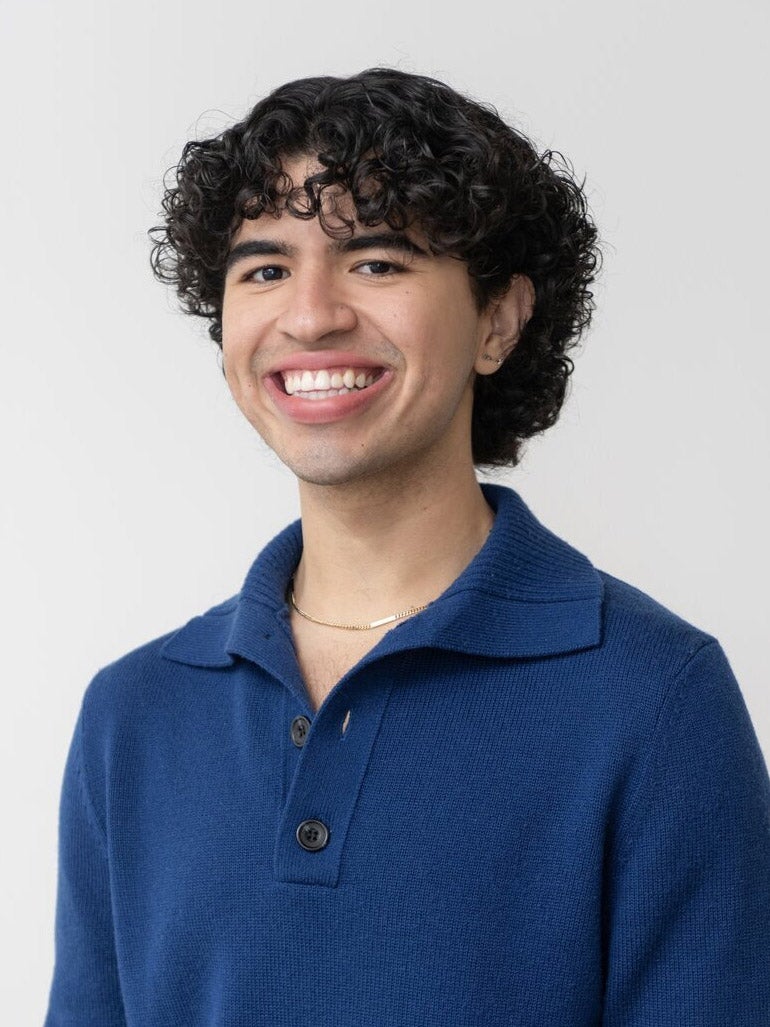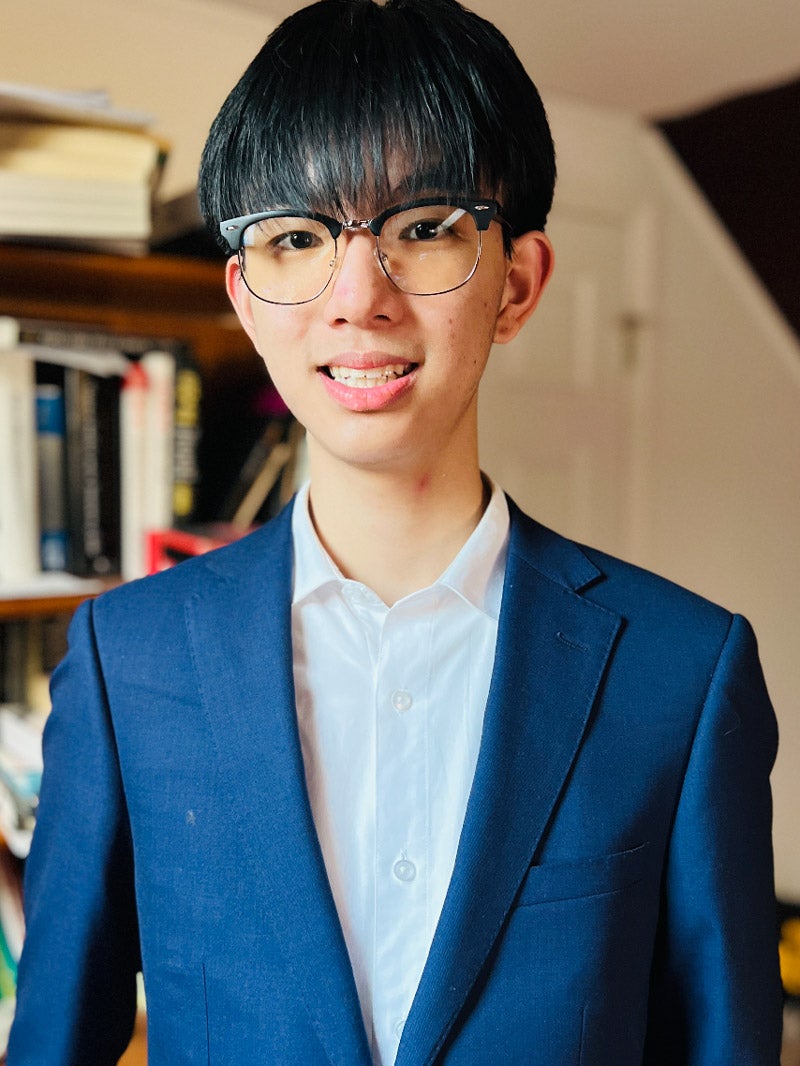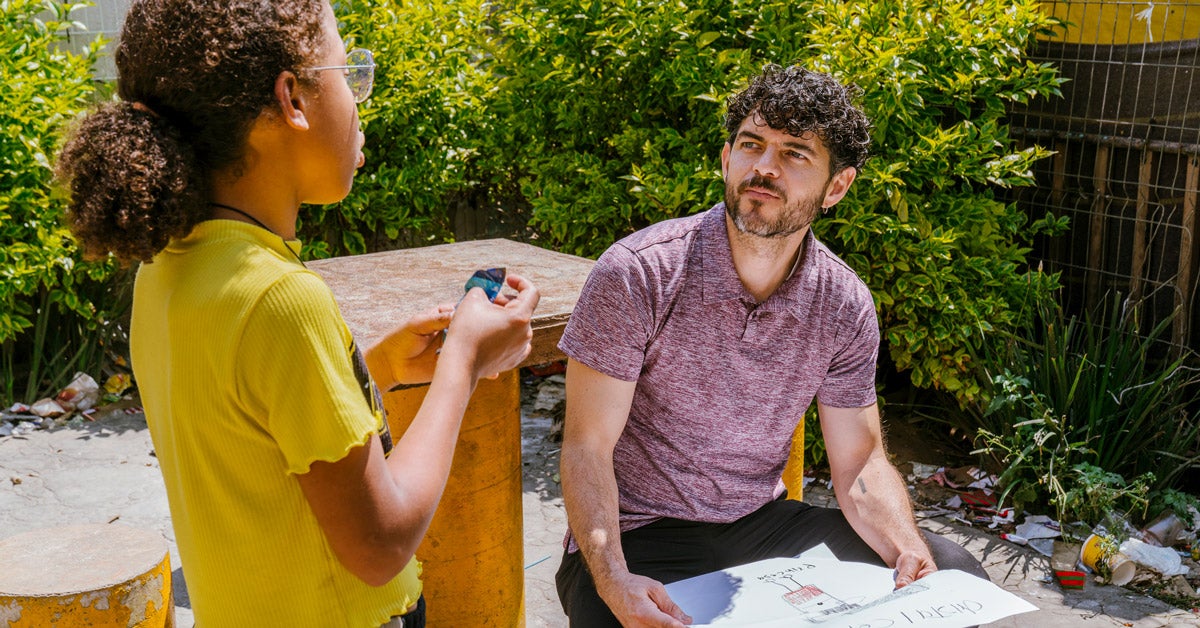
Opinion
Why are young people in the U.S. so unhappy?
Young people in the U.S. have become much less happy in recent years—a major reason the country fell, for the first time, from the top 20 in the latest World Happiness Report. People under 30 in the U.S. ranked 62nd for happiness among 143 countries surveyed. We asked some members of Gen Z whether the report reflects how they feel.

I believe that communities—including, potentially, those in the digital world—are where conversations about mental health that help youth build solidarity and resilience occur.
I was a 16-year-old with an eating disorder, and I spent nearly two years deeply isolated in hospitals. That isolation led to a kind of unhappiness that I couldn’t alleviate myself.
What I needed was to sit in my discomfort and turn it into advocacy against the system that failed to help me heal. This discomfort helped me channel the powerful emotions of that time into the communal work of changemaking.
My high school creative writing teacher was battling cancer at the time, and we started exchanging raw poems, angry emails, and frustrated musings with each other from our respective hospital beds. Those exchanges helped me recognize and express the rage I felt for a broken health care system.
Many other people have also found solace in online communities like Facebook illness groups, Reddit threads, and others. Creative expression rooted in communal grief has a long history of allowing people of all ages to find hope, healing, survival, and resistance.
It is time for us to nurture this grief’s potential to foster radical joy. We can embrace grief in community—even in digital community—and tap it as a source of power and catalyst for changemaking.
—Sophie Szew, Class of 2026, Stanford University
Sign up for Harvard Public Health
Delivered to your inbox weekly.

As a member of Generation Z, I have seen how many of us are struggling to find hope. We’re searching for it somewhere between the inherited battles against racial injustice, climate inaction, and the impossible costs of living.
Those feelings of anxiety and depression haven’t come out of a vacuum. We, too, are shaped by the negativity bias of news and social media, and this has influenced young people’s happiness levels. Negative news is associated with increased stress reactivity and better recall, suggesting that bad news sticks longer and more intensely in memory, particularly for women.
Negativity bias is not new. Since the 1960s, the news has taken a negative nosedive, particularly on topics surrounding policy and politics. What is new is social media, and an emerging body of literature indicates it takes a negative toll on its users’ mental health. People are more likely to click on news containing negative and emotional content, giving social media companies an immense incentive to develop algorithms that favor negative content.
Bad news uniquely affects young people. An early study about the way students view written descriptions found that negative comments affect young people more than positive comments. Negative emotions, events, and news also tend to evoke stronger emotional responses in young people. Another study showed that news alerts about school shootings in the U.S. make the majority of U.S. teens concerned about school safety.
Amidst a landscape in which trust in the media among American youth is historically low, our news landscape needs to shift to promote institutional trust and stories of hope. The incentives exist; solutions-based reporting and uplifting stories have been shown to encourage audience engagement, and positive news stories can increase a reader’s intentions to share the news. Our mental health depends on finding hope in all corners of life, including from the media.
—Cynthia Yue, Class of 2024, Harvard Kennedy School

I moved to the United States from Nicaragua in 2018. I’m the first in my family to graduate high school. Now I attend an Ivy League school on a full scholarship. All of these achievements are the fruits of my mother’s sacrifices—my mother, who tells people that “my son is my hope.”
But each week is filled with schoolwork, activism, and jobs to support myself. My mind and body are just trying to survive another day. I often wonder, “How do I find hope when I am supposed to be the hope?”
I know I am not alone.
As a Gen Z-er, I often feel like we’re constantly advocating for causes in a world that is perpetually in chaos and conflict. And some part of the trauma we experience is attributable to events that took place in prior generations. From my perspective, the World Happiness Report lacked one crucial variable that exacerbates unhappiness among youth: intergenerational trauma.
From global warming perpetuated by a Boomer generation focused on consumption rather than carbon to recent administrative crackdowns on college protests, the youth of today are afflicted by so much that came before us. When I see the levels of unhappiness and hopelessness among young people, I recognize the lasting impact and legacies of these historical injustices. I feel trapped in the past, and the past is trapped in me.
Band-Aids that cover up the depression and anxiety resulting from these traumas will be insufficient. Instead, give us a seat at the table. Let us have a dialogue about what matters to us and how we should address it. Organizations like Inseparable, a campaign to improve mental health care, offer compelling models of successfully integrating youth perspectives into legislative processes. In Inseparable’s case, that’s led to over 40 legislative wins as of 2024.
We need to offer something new to newer generations. It is only by acknowledging the collective trauma youth have inherited and ensuring that our voices are integral to the discussions shaping our future that we will be able to look forward with excitement.
—Jose Caballero, Class of 2026, Columbia University

Young people in the U.S. are increasingly connected to each other. But they’re also less happy than in the past. It’s becoming apparent that interconnectedness alone does not erase our vulnerability to mental illness. Instead, this new connectivity appears to amplify insecurity by too often exposing youth to intense scrutiny, unrealistic standards, and constant comparison.
The rise of social media has transformed the way my generation interacts with our peers and perceives ourselves. Excessive feedback and comparison-seeking pervades our digital age. Young people continually gauge their self-worth through likes, comments, and followers.
I’ve seen my friends spend hours and hours after school and late at night repeatedly altering and re-posting photos to maximize likes. If the post didn’t perform “well,” they would, in turn, feel inadequate. If it did perform well, whatever gratification came was fleeting, relative to the suffering they endured in the opposite scenario. Collectively, these behaviors exacerbated feelings of isolation and anxiety—taking a toll on their mental health and overall well-being.
Rather than suggesting young people are growing unhappier, maybe our definitions of happiness have been altered by the toxic brew of relativity created by hordes of influencers on platforms like Instagram and TikTok. These people are bronzed, wrinkleless, filtered, cut, and trimmed to perfection, skewing our perceptions of what happiness looks like.
The report may serve as a source of hope. It highlights a crucial yet often overlooked method for combating unhappiness among youth by promoting policies and practices that can mitigate the negative impacts of online environments. For example, schools can implement digital literacy lessons on managing digital footprints and recognizing the curated nature of social media content. They can also teach students coping strategies for times when the stress of media stimuli is overwhelming.
—Rick Yang, Class of 2024, Scarsdale High School
If you or someone you know is struggling or in crisis, help is available. Call or text 988 to reach the Suicide & Crisis Lifeline.
Lead image: calvindexter / iStock
Headshots: Courtesy of Sophie Szewp, Cynthia Yue, Jose Caballero, and Rick Yang
Republish this article
<p>Four students on their biggest stressors and how they cope</p>
<p>Written </p>
<p>This <a rel="canonical" href="https://harvardpublichealth.org/mental-health/world-happiness-report-says-young-adults-are-unhappy-why/">article</a> originally appeared in<a href="https://harvardpublichealth.org/">Harvard Public Health magazine</a>. Subscribe to their <a href="https://harvardpublichealth.org/subscribe/">newsletter</a>.</p>
<p class="has-drop-cap"><em>Young people in the U.S. have become much less happy in recent years—a major reason the country fell, for the first time, from the top 20 in the latest </em><a href="https://worldhappiness.report/ed/2024/" target="_blank" rel="noreferrer noopener"><em>World Happiness Report</em></a><em>. People under 30 in the U.S. ranked 62nd for happiness among 143 countries surveyed. We asked some members of Gen Z whether the report reflects how they feel.</em></p>
<p>I believe that communities—including, potentially, those in the digital world—are where conversations about mental health that <a href="https://www.sciencedirect.com/science/article/abs/pii/S014521341400283X?via%3Dihub" target="_blank" rel="noreferrer noopener">help youth build solidarity and resilience</a> occur.</p>
<p>I was a 16-year-old with an eating disorder, and I spent nearly two years deeply isolated in hospitals. That isolation led to a kind of unhappiness that I couldn’t alleviate myself.</p>
<p>What I needed was to sit in my discomfort and turn it into advocacy against the system that failed to help me heal. This discomfort helped me channel the powerful emotions of that time into the communal work of changemaking.</p>
<p>My high school creative writing teacher was battling cancer at the time, and we started exchanging raw poems, angry emails, and frustrated musings with each other from our respective hospital beds. Those exchanges helped me recognize and express the rage I felt for a broken health care system.</p>
<p>Many other people have also found solace in online communities like Facebook illness groups, Reddit threads, and others. Creative expression rooted in communal grief has a long history of allowing people of all ages to find hope, healing, survival, and resistance.</p>
<p>It is time for us to nurture this grief’s potential to foster radical joy. We can embrace grief in community—even in digital community—and tap it as a source of power and catalyst for changemaking.</p>
<p><strong>—Sophie Szew, Class of 2026, Stanford University</strong></p>
<p>As a member of Generation Z, I have seen how many of us are struggling to find hope. We’re searching for it somewhere between the inherited battles against racial injustice, climate inaction, and the impossible costs of living.</p>
<p>Those feelings of anxiety and depression haven’t come out of a vacuum. We, too, are <a href="https://www.ncbi.nlm.nih.gov/pmc/articles/PMC7187375/" target="_blank" rel="noreferrer noopener">shaped by the negativity bias of news</a> and social media, and this has influenced young people’s happiness levels. Negative news is associated with <a href="https://pubmed.ncbi.nlm.nih.gov/23071755/" target="_blank" rel="noreferrer noopener">increased stress reactivity</a> and better recall, suggesting that bad news sticks longer and more intensely in memory, particularly for women.</p>
<p>Negativity bias is not new. Since the 1960s, the news has taken a <a href="https://research.hks.harvard.edu/publications/getFile.aspx?Id=1" target="_blank" rel="noreferrer noopener">negative nosedive</a>, particularly on topics surrounding policy and politics. What is new is social media, and an emerging body of literature indicates it <a href="https://www.ncbi.nlm.nih.gov/pmc/articles/PMC4183915/" target="_blank" rel="noreferrer noopener">takes a negative toll</a> on its users’ mental health. People are <a href="https://rdcu.be/dF4He" target="_blank" rel="noreferrer noopener">more likely to click</a> on news containing negative and emotional content, giving social media companies an immense incentive to develop algorithms that favor negative content.</p>
<p>Bad news uniquely affects young people. An <a href="https://psycnet.apa.org/record/1967-11833-001" target="_blank" rel="noreferrer noopener">early study about the way students view written descriptions</a> found that negative comments affect young people more than positive comments. Negative emotions, events, and news also tend to <a href="https://yppactionframe.fas.harvard.edu/files/actionframe/files/2017_commonsense_newsandamericaskids.pdf" target="_blank" rel="noreferrer noopener">evoke stronger emotional responses</a> in young people. Another study showed that news alerts about school shootings in the U.S. make the <a href="https://www.pewresearch.org/short-reads/2018/04/18/a-majority-of-u-s-teens-fear-a-shooting-could-happen-at-their-school-and-most-parents-share-their-concern/" target="_blank" rel="noreferrer noopener">majority of U.S. teens</a> concerned about school safety.</p>
<p>Amidst a landscape in which <a href="https://iop.harvard.edu/youth-poll/47th-edition-spring-2024" target="_blank" rel="noreferrer noopener">trust in the media among American youth is historically low</a>, our news landscape needs to shift to promote institutional trust and stories of hope. The incentives exist; solutions-based reporting and uplifting stories have been <a href="https://academic.oup.com/joc/article/67/5/781/4642140" target="_blank" rel="noreferrer noopener">shown to encourage audience engagement</a>, and positive news stories <a href="https://www.tandfonline.com/doi/full/10.1080/08824096.2016.1186619" target="_blank" rel="noreferrer noopener">can increase a reader’s intentions to share the news</a>. Our mental health depends on finding hope in all corners of life, including from the media.</p>
<p><strong>—Cynthia Yue, Class of 2024, Harvard Kennedy School</strong></p>
<p>I moved to the United States from Nicaragua in 2018. I’m the first in my family to graduate high school. Now I attend an Ivy League school on a full scholarship. All of these achievements are the fruits of my mother’s sacrifices—my mother, who tells people that “my son is my hope.”</p>
<p>But each week is filled with schoolwork, activism, and jobs to support myself. My mind and body are just trying to survive another day. I often wonder, “How do I find hope when I am supposed to <em>be</em> the hope?”</p>
<p>I know I am not alone.</p>
<p>As a Gen Z-er, I often feel like we're constantly advocating for causes in a world that is perpetually in chaos and conflict. And some part of the trauma we experience is attributable to events that took place in prior generations. From my perspective, the World Happiness Report lacked one crucial variable that exacerbates unhappiness among youth: intergenerational trauma.</p>
<p>From global warming perpetuated by a Boomer generation focused on consumption rather than carbon to recent administrative crackdowns on college protests, the youth of today are afflicted by so much that came before us. When I see the levels of unhappiness and hopelessness among young people, I recognize the lasting impact and legacies of these historical injustices. I feel trapped in the past, and the past is trapped in me.</p>
<p>Band-Aids that cover up the depression and anxiety resulting from these traumas will be insufficient. Instead, give us a seat at the table. Let us have a dialogue about what matters to us and how we should address it. Organizations like <a href="https://www.inseparable.us/" target="_blank" rel="noreferrer noopener">Inseparable</a>, a campaign to improve mental health care, offer compelling models of successfully integrating youth perspectives into legislative processes. In Inseparable’s case, that’s led to over 40 legislative <a href="https://www.inseparable.us/impact.pdf" target="_blank" rel="noreferrer noopener">wins</a> as of 2024.</p>
<p>We need to offer something new to newer generations. It is only by acknowledging the collective trauma youth have inherited and ensuring that our voices are integral to the discussions shaping our future that we will be able to look forward with excitement.</p>
<p><strong>—Jose Caballero, Class of 2026, Columbia University</strong></p>
<p>Young people in the U.S. are increasingly connected to each other. But they’re also less happy than in the past. It’s becoming apparent that interconnectedness alone does not erase our vulnerability to mental illness. Instead, this new <a href="https://www.hhs.gov/sites/default/files/sg-youth-mental-health-social-media-advisory.pdf" target="_blank" rel="noreferrer noopener">connectivity appears to amplify insecurity</a> by too often exposing youth to intense scrutiny, unrealistic standards, and constant comparison.</p>
<p>The rise of social media has transformed the way my generation interacts with our peers and perceives ourselves. Excessive feedback and comparison-seeking <a href="https://jamanetwork.com/journals/jamapediatrics/fullarticle/2799812" target="_blank" rel="noreferrer noopener">pervades our digital age</a>. Young people continually gauge their self-worth through likes, comments, and followers.</p>
<p>I’ve seen my friends spend hours and hours after school and late at night repeatedly altering and re-posting photos to maximize likes. If the post didn't perform “well,” they would, in turn, feel inadequate. If it did perform well, whatever gratification came was fleeting, relative to the suffering they endured in the opposite scenario. Collectively, these behaviors exacerbated feelings of isolation and anxiety—taking a toll on their mental health and overall well-being.</p>
<p>Rather than suggesting young people are growing unhappier, maybe our definitions of happiness have been altered by the toxic brew of relativity created by hordes of influencers on platforms like Instagram and TikTok. These people are bronzed, wrinkleless, filtered, cut, and trimmed to perfection, skewing our perceptions of what happiness looks like.</p>
<p class=" ">The report may serve as a source of hope. It highlights a crucial yet often overlooked method for combating unhappiness among youth by promoting policies and practices that can mitigate the negative impacts of online environments. For example, schools can implement digital literacy lessons on managing digital footprints and recognizing the curated nature of social media content. They can also teach students coping strategies for times when the stress of media stimuli is overwhelming. </p>
<p class=" t-has-endmark t-has-endmark"><strong>—Rick Yang, Class of 2024, Scarsdale High School</strong></p>
<p class="is-style-t-caption"><em>If you or someone you know is struggling or in crisis, help is available. Call or text 988 to reach the Suicide & Crisis Lifeline.</em></p>
<p class="is-style-t-caption">Lead image: calvindexter / iStock</p>
<script async src="https://www.googletagmanager.com/gtag/js?id=G-S1L5BS4DJN"></script>
<script>
window.dataLayer = window.dataLayer || [];
if (typeof gtag !== "function") {function gtag(){dataLayer.push(arguments);}}
gtag('js', new Date());
gtag('config', 'G-S1L5BS4DJN');
</script>
Republishing guidelines
We’re happy to know you’re interested in republishing one of our stories. Please follow the guidelines below, adapted from other sites, primarily ProPublica’s Steal Our Stories guidelines (we didn’t steal all of its republishing guidelines, but we stole a lot of them). We also borrowed from Undark and KFF Health News.
Timeframe: Most stories and opinion pieces on our site can be republished within 90 days of posting. An article is available for republishing if our “Republish” button appears next to the story. We follow the Creative Commons noncommercial no-derivatives license.
When republishing a Harvard Public Health story, please follow these rules and use the required acknowledgments:
- Do not edit our stories, except to reflect changes in time (for instance, “last week” may replace “yesterday”), make style updates (we use serial commas; you may choose not to), and location (we spell out state names; you may choose not to).
- Include the author’s byline.
- Include text at the top of the story that says, “This article was originally published by Harvard Public Health. You must link the words “Harvard Public Health” to the story’s original/canonical URL.
- You must preserve the links in our stories, including our newsletter sign-up language and link.
- You must use our analytics tag: a single pixel and a snippet of HTML code that allows us to monitor our story’s traffic on your site. If you utilize our “Republish” link, the code will be automatically appended at the end of the article. It occupies minimal space and will be enclosed within a standard <script> tag.
- You must set the canonical link to the original Harvard Public Health URL or otherwise ensure that canonical tags are properly implemented to indicate that HPH is the original source of the content. For more information about canonical metadata, click here.
Packaging: Feel free to use our headline and deck or to craft your own headlines, subheads, and other material.
Art: You may republish editorial cartoons and photographs on stories with the “Republish” button. For illustrations or articles without the “Republish” button, please reach out to republishing@hsph.harvard.edu.
Exceptions: Stories that do not include a Republish button are either exclusive to us or governed by another collaborative agreement. Please reach out directly to the author, photographer, illustrator, or other named contributor for permission to reprint work that does not include our Republish button. Please do the same for stories published more than 90 days previously. If you have any questions, contact us at republishing@hsph.harvard.edu.
Translations: If you would like to translate our story into another language, please contact us first at republishing@hsph.harvard.edu.
Ads: It’s okay to put our stories on pages with ads, but not ads specifically sold against our stories. You can’t state or imply that donations to your organization support Harvard Public Health.
Responsibilities and restrictions: You have no rights to sell, license, syndicate, or otherwise represent yourself as the authorized owner of our material to any third parties. This means that you cannot actively publish or submit our work for syndication to third-party platforms or apps like Apple News or Google News. Harvard Public Health recognizes that publishers cannot fully control when certain third parties aggregate or crawl content from publishers’ own sites.
You may not republish our material wholesale or automatically; you need to select stories to be republished individually.
You may not use our work to populate a website designed to improve rankings on search engines or solely to gain revenue from network-based advertisements.
Any website on which our stories appear must include a prominent and effective way to contact the editorial team at the publication.
Social media: If your publication shares republished stories on social media, we welcome a tag. We are @PublicHealthMag on X, Threads, and Instagram, and Harvard Public Health magazine on Facebook and LinkedIn.
Questions: If you have other questions, email us at republishing@hsph.harvard.edu.


